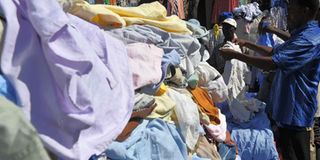Breaking News: At least 10 feared to have drowned in Makueni river
‘Mtumba’ means bale, nay, second-hand in market language

A man samples second-hand clothes (locally known as mitumba) at the Gikomba open-air market on June 25, 2012, in Nairobi. Photo/AFP
What you need to know:
- Second-hand clothing was initially imported as duty-free charity to Kenya in the 1970s and the 1980s.
- While ‘in camera’ in the judicial system refers to private sessions, in the mitumba business, ‘camera’ refers to having the first rights to the bale, and therefore access to the best selection of items it contains.
MITUMBA
Mitumba is now synonymous with second-hand clothes in East Africa.
It is a Kiswahili word for “bales” or “bundles”, but the modern-day use is in reference to the way second-hand clothes are packed in plastic bundles prior to shipping.
Second-hand clothing was initially imported as duty-free charity to Kenya in the 1970s and the 1980s.
Charity organisations started disposing of the excess clothes by selling them to raise more money for their work.
From 1985 to 1991, Kenya and Tanzania implemented trade liberalisation policies that removed the protectionist measures that had stifled the mitumba (or mtumba) market for two decades to sustain the local textile industry.
The result was a mitumba boom that has now grown into a multi-million dollar industry from which the government benefits in custom tax and other charges on traders.
While ‘in camera’ in the judicial system refers to private sessions, in the mitumba business, ‘camera’ refers to having the first rights to the bale, and therefore access to the best selection of items it contains.
‘Camera’ products tend to attract higher prices than the rest. Mitumba equivalents in Nigeria and India are known as Okrika and Bhandiwala respectively.
GIKOMBA
Kenya’s most famous mitumba market is Gikomba, situated only a short distance from the Country Bus Station in Nairobi.
It is thus a walking distance from the city centre. It flourished from a small market in 1991 to a labyrinth of stalls selling clothes, shoes and variety of household items. It is the biggest second-hand clothing market in Kenya.
The exact etymology of Gikomba is unclear, although there are suggestions that it might be have a Kikuyu origin, or at least Bantu. The closest root word, gukomba, means ‘to take on credit’.
TOI MARKET
The only mitumba market in Nairobi that rivals Gikomba in fame and prices is Toi Market in Kibera. It has grown phenomenally in the last decade.
Toi comes from a word that means ‘mud’ in the language of the Nubians, who were the first settlers in Kibera. In 1983, the government acquired the land that Toi Market partly stands on today.
The land had been acquired for putting up a courthouse, but a group of traders set up businesses and the place became known as Makina Market.
Due to its rapid growth, more traders moved into the adjacent open space, which became the bulk of today’s Toi Market. They did not own this land, but merely occupied it for convenience.
In 1991, the traders took advantage of a presidential visit to demand for a permanent market.
The resulting market was known as Kibera Hawkers Market. Most of the stalls were demolished in 1996 at the height of a case between the traders and the private owners of the land.
JUA KALI
In direct translation, Jua Kali is Kiswahili for ‘hot sun’. In ordinary use, it is associated with the informal metal fabrication industry that has flourished in Kenya since the 1980s.
The term originally referred to anyone working in self-employment in Kenya. It alluded to the hardships of such jobs.
Today, it has picked up an alternative meaning in Kenyan lingo, as low quality or informally made. A similar etymological evolution occurred on mitumba.
WAKULIMA MARKET(MARIGITI)
While Gikomba and Toi markets are famous for second-hand clothing, Wakulima Market is known for farm produce. It is the largest wholesale farmers market in the country. In fact, wakulima is Kiswahili for farmers.
In ordinary conversation, it is referred to as ‘Marigiti’, which is a corruption of the word ‘market’. It is located on Haile Sellasie Avenue in Nairobi, just before the Country Bus Station when approached from the city centre.
There are similar markets in other major towns in Kenya, but smaller in size. Many of them are also known as Marikiti or Marigiti, a name that has become synonymous with a farm produce market.
MASAI MARKET
The history of the Masai Market as a series of open-air markets in Nairobi and other places is unclear.
However, the original market occupied a space demarcated by Kijabe Street, Globe round-about and Slip Road in Nairobi. The market was moved to pave way for road expansion.
The market is now a mobile entity, rotating around designated spots in the city on different days. It has become a vibrant attraction to art and craft enthusiasts, including tourists.
Traders sell handicraft, kikoys, curios, baskets, beadworks, carvings and branded T-shirts.


